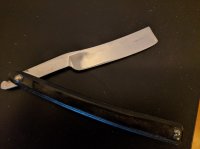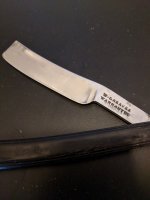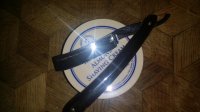You can't sell or trade yet, but I thought a WTB post is ok? Might be worth checking out.I am unable to post in the BST section yet... Unfortunatly. or i would be all over it.
You are using an out of date browser. It may not display this or other websites correctly.
You should upgrade or use an alternative browser.
You should upgrade or use an alternative browser.
Who's shaving with the oldest razor?
- Thread starter DogHair
- Start date
Take good care of that fantastic old lady[emoji7] [emoji7] [emoji7]This may not be the oldest razor, it was made in 1880; but to know that I was the FIRST person to shave with this razor makes it exceptional to me.
View attachment 685322View attachment 685323
I have a pressure flaked flint tool that my great-grandfather found in a cotton field in North Carolina in the 1870's. I was told it was most likely a shaving implement, and made by a Cherokee native American. I never tried shaving with it until last week. I have now used it a few times and it works, but feels like shaving with a razor off of a 1K stone. Although I can not be sure of this tools age, it is safe to assume it was made at least 350 years ago.
Last edited:
Lets see some pictures of that!
I gotta dredge this thread back to the top, it's excellent! So much great history!
Here are my oldest razors, if any of you guys have any information of history and age of these old timers
View attachment 718293View attachment 718294
View attachment 718293View attachment 718294
All English. Bottom one ~1800, other two around ~1810-20's ish.
Top ones scales are certainly not original, but I need a better pic of the other two. But they also look more modern than the blades.
Top ones scales are certainly not original, but I need a better pic of the other two. But they also look more modern than the blades.
I got these in the mail today. Still in "as found" condition, but a pretty cool find.
A matched pair of shorty stubtail travel razors, in ivory, and their original travel case. I can't quite 100% make out the maker, but I believe it is probably Nowill. Date from ~1800ish.
Last edited:
Not sure I ever posted in this thread, so this is either a fresh post, or a repost.. John Barber, and I'm guessing it's around 1820's

Oh those are sweet!!!View attachment 835481 View attachment 835482 A chance to resurrect my favourite thread... Such a shame most of the pictures are dead.
I got these in the mail today. Still in "as found" condition, but a pretty cool find.
A matched pair of shorty stubtail travel razors, in ivory, and their original travel case. I can't quite 100% make out the maker, but I believe it is probably Nowill. Date from ~1800ish.
View attachment 835481 View attachment 835482 A chance to resurrect my favourite thread... Such a shame most of the pictures are dead.
I got these in the mail today. Still in "as found" condition, but a pretty cool find.
A matched pair of shorty stubtail travel razors, in ivory, and their original travel case. I can't quite 100% make out the maker, but I believe it is probably Nowill. Date from ~1800ish.
Very, very nice!
(Also, your Laphroaig signature line is perfect.)
View attachment 835481 View attachment 835482 A chance to resurrect my favourite thread... Such a shame most of the pictures are dead.
I got these in the mail today. Still in "as found" condition, but a pretty cool find.
A matched pair of shorty stubtail travel razors, in ivory, and their original travel case. I can't quite 100% make out the maker, but I believe it is probably Nowill. Date from ~1800ish.
Very impressive!!
I can't believe I haven't posted on this thread yet...this is the pride and joy of my very small shaving collection.
Early Greaves - as it seems to predate the "&Sons" and the "Shaef works". I like to believe, and tell people that it's "american revolution era". When I first got it, i was in Virginia visiting my parents, and we went to the smithsonian castle museum...it was amazing to see the blade i used to shave that morning predated a lot of the stuff there.
It's crazy sharp and in amazing condition. I once cut myself, AND the towel on it whilst wiping it with a towel...i went nowhere near the edge. I'm hoping to be able to keep the scales (thank god it's no cellulite), but it's a bit broken as you can see. (It MAY also need a few passes on the hone, or a pasted strop..owing to the 'towel' incident, but whatever).


Early Greaves - as it seems to predate the "&Sons" and the "Shaef works". I like to believe, and tell people that it's "american revolution era". When I first got it, i was in Virginia visiting my parents, and we went to the smithsonian castle museum...it was amazing to see the blade i used to shave that morning predated a lot of the stuff there.
It's crazy sharp and in amazing condition. I once cut myself, AND the towel on it whilst wiping it with a towel...i went nowhere near the edge. I'm hoping to be able to keep the scales (thank god it's no cellulite), but it's a bit broken as you can see. (It MAY also need a few passes on the hone, or a pasted strop..owing to the 'towel' incident, but whatever).


Very very nice. While I am far from the expert on dating straight razors, I had gone through and researched a decent bit over the years, and my best not professional opinion on that is that it's a tad later then American revolution. The blade grind, shape, and tang suggest it's in the early 1800's. Very early.. 1810-1820 or so, perhaps? It is in beautiful condition and should easily last another 200 years plus.I can't believe I haven't posted on this thread yet...this is the pride and joy of my very small shaving collection.
Early Greaves - as it seems to predate the "&Sons" and the "Shaef works". I like to believe, and tell people that it's "american revolution era". When I first got it, i was in Virginia visiting my parents, and we went to the smithsonian castle museum...it was amazing to see the blade i used to shave that morning predated a lot of the stuff there.
It's crazy sharp and in amazing condition. I once cut myself, AND the towel on it whilst wiping it with a towel...i went nowhere near the edge. I'm hoping to be able to keep the scales (thank god it's no cellulite), but it's a bit broken as you can see. (It MAY also need a few passes on the hone, or a pasted strop..owing to the 'towel' incident, but whatever).
NOO damn it, I'm sticking to my american revolution story!Very very nice. While I am far from the expert on dating straight razors, I had gone through and researched a decent bit over the years, and my best not professional opinion on that is that it's a tad later then American revolution. The blade grind, shape, and tang suggest it's in the early 1800's. Very early.. 1810-1820 or so, perhaps? It is in beautiful condition and should easily last another 200 years plus.

Realistically, though I thought as much - sometime around or shortly after the napoleonic wars (mostly because W. Greaves' history that I've read around the internet gets very flakey pre-1800, with a lot of "purportedly" type of qualifiers). I DO hope it lasts another 200 years, that'd be awesome. Hopefully someday I'll pass it down.
Yeah, I know, and I can understand. The shape of straight razors ground to have shoulders like that one does just didn't really start to appear till the very very late 1700's and early 1800's, from every example I have seen of verified dated razors in collections and whatnot. Even then, that's only 20-30 years off of the American revolution era, so still super impressive to consider, even more so considering the great shape that blade is in still.NOO damn it, I'm sticking to my american revolution story!
Realistically, though I thought as much - sometime around or shortly after the napoleonic wars (mostly because W. Greaves' history that I've read around the internet gets very flakey pre-1800, with a lot of "purportedly" type of qualifiers). I DO hope it lasts another 200 years, that'd be awesome. Hopefully someday I'll pass it down.
Oh interesting, I did know that older straights had less shoulders. Why the change in grinding btw? (was it just one of those "one guy did it, and it just caught on" things?).Yeah, I know, and I can understand. The shape of straight razors ground to have shoulders like that one does just didn't really start to appear till the very very late 1700's and early 1800's, from every example I have seen of verified dated razors in collections and whatnot. Even then, that's only 20-30 years off of the American revolution era, so still super impressive to consider, even more so considering the great shape that blade is in still.
And yea, I wish I could do psychometry on these old razors to see who used them through the years, and how they were kept. I mean just thinking about how little people back in 1800's would have had, someone managed to keep this thing without breaking it, or getting it rusted beyond help all these years!
P.S: i LOVE learning about straight razors, it's REALLY interesting how it interacts with other events in history as well.
Speaking of, I'd LOVE to see some pre-industrial revolution straights...how rare are those?
Oh interesting, I did know that older straights had less shoulders. Why the change in grinding btw? (was it just one of those "one guy did it, and it just caught on" things?).
P.S: i LOVE learning about straight razors, it's REALLY interesting how it interacts with other events in history as well.
Speaking of, I'd LOVE to see some pre-industrial revolution straights...how rare are those?
I am guessing the technology level increased to make a grind that like more feasible to reproduce over and over again, while at the same time that grind/shape had many advantages over the previous typical shape. It's easier and faster to hone, and will last longer over multiple honings before the blade edge wears away up to where the shoulders are.
Examples of pre-Industrial Revolution would appear to be extremely rare, for whatever reasons.
Similar threads
- Replies
- 9
- Views
- 763
- Replies
- 29
- Views
- 4K


